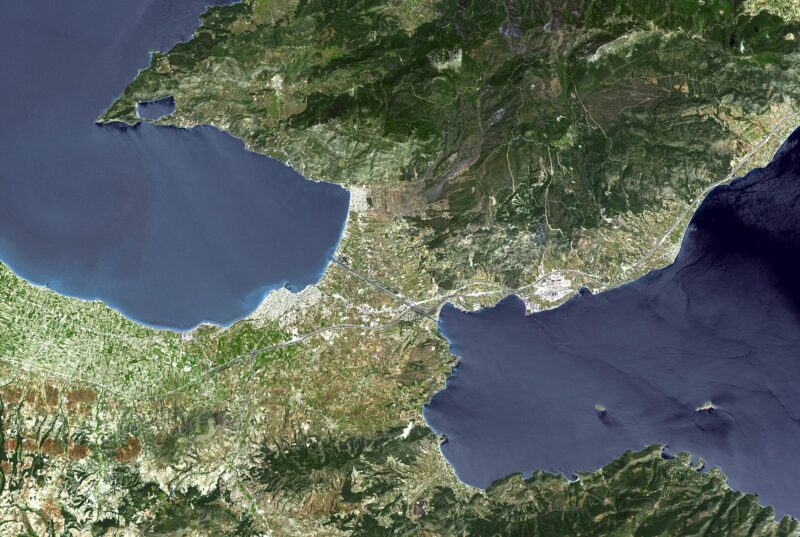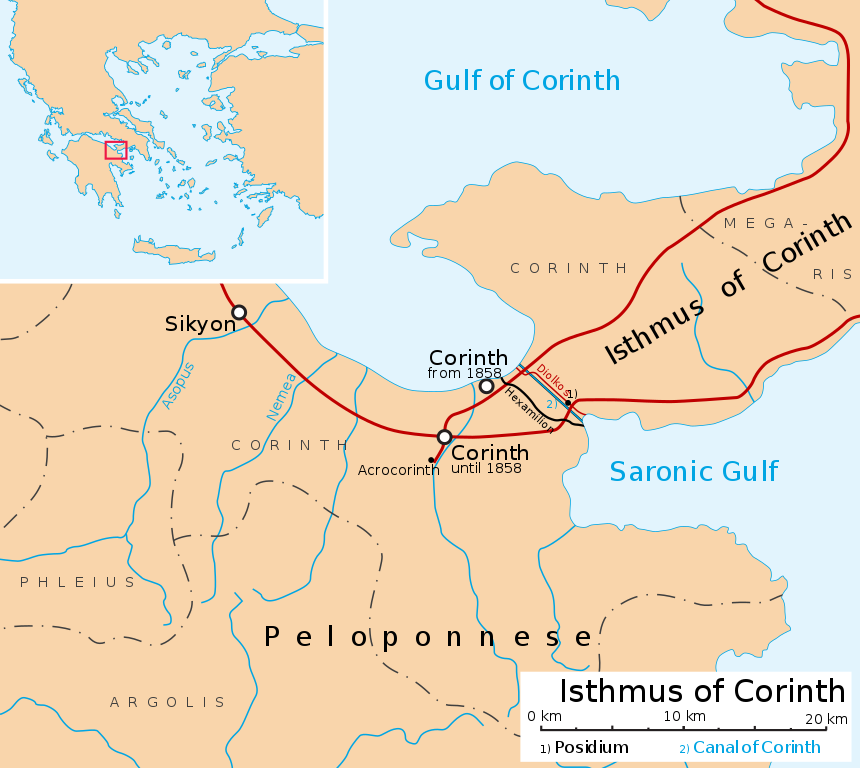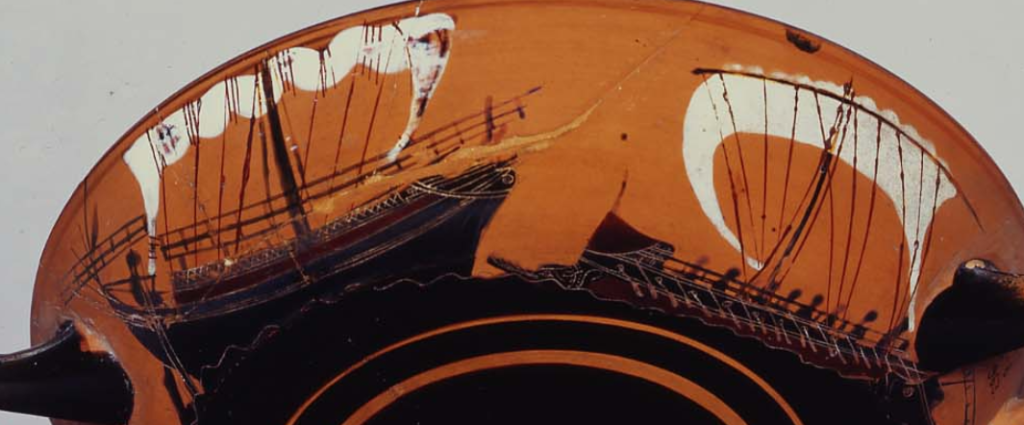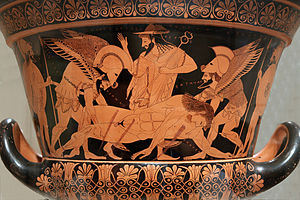The Isthmus of Corinth.
Mainland Greece is connected to its southern Peloponnese, a peninsula, by a narrow isthmus. This is a narrow strip of land, approximately 6km, rising to 80 metres above sea level. To the east of it is the Saronic gulf and the west is the Gulf of Corinth.
When viewed from above the situation, and opportunity, can be made out more clearly. What if you could move ships or their cargo across this strip of land? This would offer a very handy shortcut and prevent a much longer journey around the coast of the southern Peloponnese. A city which controlled this area would benefit hugely both commercially and in a wider strategic sense.

NASA/GSFC/METI/ERSDAC/JAROS, and U.S./Japan ASTER Science Team

The debut of the Diolkos.
Writing in the imperial Roman period the Greek geographer Strabo was the first to use the word ‘Diolkos’. In the modern period this has become the term used to describe a trackway running across the isthmus upon which ships and goods were apparently transported. The building of it was associated with Periander, a ruler of Corinth in the 6th century BC. However, much of this definition can either be discounted or critiqued and instead a new reading of what the Diolkos was can be formed through recent work and studies. I’ve outlined some of these in this piece, but you can find the articles at the footer.
I’ll come to Strabo in a moment and instead I’ll begin with the first reference we have for ships potentially being moved across the isthmus. In 428 BC the Athenian historian Thucydides wrote how Spartans were getting machines ready with which they were to haul their ships across. It’s a fleeting mention, almost literally so.
In 411 BC Thucydides wrote that 21 ships were moved across the isthmus as part of a military operation. However, the intention of it as a surprise tactic was undone when the Corinthians stayed on to celebrate their games. Much to the chagrin of the Spartans.
In both instances the context was military and here we meet an early challenge. We have little to no reference of commercial activity, off the Diolkos facilitating trade. This tactic of moving military ships across narrow strips of land wasn’t restricted to the Isthmus of Corinth, Thucydides also referred to this occurring at Leukas, though today the isthmus there has since disappeared.
Thucydides had little to say about how ships were moved or really any details. This has caused some debate, was Thucydides’ reference to the movement of ships across land acknowledgment that this was common? Or was it because it was unusual and, much like any novel situation, worth reporting.
A tyrant and Strabo.
Leaving Thucydides behind we move to a much later source. It was Strabo who coined the word ‘Diolkos’. However, his use of the word is argued as a more general description of a narrow section of the isthmus. Not a specific trackway. The definition of it meaning a distinct engineered trackway upon which ships were moved is a much more modern definition. When Dr Habbo Gerhard Lolling identified part of what is now known as the Diolkos he presumed that this was for the hauling of ships. The definition stuck.
Work on the excavation of parts of the Diolkos (I’ll use the word for ease of purpose) do supply some answers to basic questions. It does seem that parts of it can be dated to circa 600 BC when Periander ruled Corinth and who is credited with building it. Though not all of it has been excavated, due in part to the construction of the Corinthian Canal, in some sections there are trackways which suggest wheeled vehicles were used. Of the excavated sections the width varies at points, 4.2-5.8 metres and 3.4-4 metres. As mentioned the Isthmus of Corinth wasn’t flat and the trackway, rather than cut a straight line, made use of the contours of the landscape to keep the incline to a minimum.
What’s curious though is that wear and tear by hooves hasn’t been noted. We have trackways and even some interesting carved letters which have helped to date it. But the absence of wear and tear by oxen or other similar animals has prompted questions. How were they moving the vehicles?
As with many aspects of the Diolkos, we cannot be sure. One suggestion is that pulleys and ropes acted in part as a more effective way of moving any vehicles and what was on them. The sheer logistics of using oxen needs to be confronted and offers a good rationale as to why they weren’t used. For a start to move the suggested weight of goods (which I will come to) you would need many oxen and yoking them would be a serious issue. It’s been estimated that hauling 25 tonnes of olive oil would require 50 pairs of oxen. This many animals would need a large amount of resources to be able to undertake that effort. Logistically it doesn’t seem feasible to have used them.
The above example deals with one suggested use of the Diolkos, that ships weren’t hauled across but instead their goods were. This makes sense and avoids the tricky situation of explaining how you might move a large commercial ship as well as it’s cargo. As we’ve seen the cargo would be a challenge, But a large commercial vessel? This would not only be difficult in terms of weight as these could easily surpass 20 tonnes, but then you had the shape of the ship to contend with. Such a large object wasn’t designed to exist much out of water. You can easily imagine where a slip or movement whilst en route could cause structural damage.
And, of course, if one were to fall or topple then nothing could be moved along the route of the Diolkos.

Re-evaluating the Diolkos.
If moving large ships and cargo wasn’t feasible what are we to make of it? A couple of suggestions reframe the Diolkos as more of a general route used to facilitate trade between the ports in the Saronic gulf and Gulf of Corinth, but on a lesser scale than the large ships and cargos. One example might be the movement of large objects across to the necessary port on either side. Large cut stone or columns, weighing 8 tonnes each seems much more feasible. Perhaps these weren’t always unloaded from one side to the other but joined the trackway at a set point where they could be more quickly moved along it.
As for ships, well there is a possibility that small ships were used. To understand this, we move back to Strabo and before I go further with him it’s important to note that Strabo was writing centuries after Thucydides made his reports on the hauling of military vessels. An easy trap often experienced in ancient history is to treat all sources as observing the same event or feature when they might be experiencing a very different version of it.
Back then to Strabo, in Book VIII of his Geography he wrote about the isthmus that:
“We have already said that the isthmus at the road where they draw vessels over-land from one sea to the other is 40 stadia across”.
Though the word used here is ‘vessels’ the specific word used was πορθμεία. It’s been noted that Strabo used this word elsewhere when referring to small boats, mainly ferryboats. Perhaps then if a boat was moved across the Diolkos then it was of a very small sort.
This might explain some of the detail which Thucydides provided. After all in his accounts he referred to specific machines being used to move the much larger ships (a trireme had been estimated at having a displacement of around 27 tonnes when fully equipped). This can be read as meaning that the normal type of machinery used wasn’t capable of moving the much larger vessels.
Diolkos – myth or reality?
With the above considered it seems much more feasible that smaller goods were moved along the Diolkos and in some instances small boats. The exception was the large military ships, and this is given more coverage by the ancient sources because it was a real feat. As Pettigrew outlines, the likes of Pliny and Strabo wrote accounts of military vessels being moved as part of a wider narrative where this activity was framed as a major achievement. The grandfather of Marc Antony, Marcus Antonius, even celebrated this achievement in a poem.
Extrapolating this to mean that the Diolkos was a sort of highway for large ships to make it from east to west and vice versa doesn’t fit the evidence. And though new evidence can change a position (as it should) the logistics of this activity being a regular occurrence doesn’t fit. It’s akin to the overestimation of armies which could never have been supplied. Logistics and numbers are a neat way of cutting through hyperbole and misrepresentation.
It also, pun intended, sells the role of the Diolkos short. It was very important in what it did offer – an important route upon which goods could be moved. We still lack the understanding of how some of the pieces fit, but it doesn’t lose its shine or importance because great hulls weren’t being moved across it.
If you’re interested in logistics and how goods were moved in antiquity why not have a read about how camels were used by the Mesopotamians, Greeks and Romans?
Further reading.
Pettegrew, D. The Diolkos of Corinth. American Journal of Archaeology. Vol 115. No4 (2011).
Werner, W. The largest ship trackway in ancient times: the Diolkos of the Isthmus of Corinth, Greece, and early attempts to build a canal.
Drijvers, JW. Strabo VIII 2,1 (C335): ΠΟΡΘΜΕΙΑ and the “Diolkos”.



